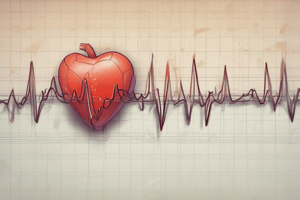Podcast
Questions and Answers
What does the P wave represent?
What does the P wave represent?
It represents the electrical activity of the heart's atria when the SA node is activated.
What is the QT interval?
What is the QT interval?
The QT interval represents the time of ventricular activity including both depolarization and repolarization.
What does the PR interval represent?
What does the PR interval represent?
It represents the time taken for the electrical impulse to spread through the atria and down to the heart's ventricular muscles.
Explain the T-wave.
Explain the T-wave.
What is the ST segment?
What is the ST segment?
What is the QRS complex?
What is the QRS complex?
What is the AV node function?
What is the AV node function?
Flashcards are hidden until you start studying
Study Notes
P Wave
- Represents electrical activity in the heart's atria upon SA node activation.
- Appears positive in most ECG leads, above the isoelectric line.
- Should be rounded, avoiding peaked, pointed, or notched shapes.
QT Interval
- Indicates total ventricular activity: depolarization and repolarization.
- Measured from the beginning of the QRS complex to the end of the T wave.
- Normal range: 0.36 to 0.44 seconds (approximately 9-11 boxes).
- Varies based on patient gender, age, and heart rate.
PR Interval
- Reflects time for electrical impulse to travel through the atria and AV node to the ventricles.
- Normal measurement: 0.12 to 0.20 seconds (3 to 5 small boxes).
- Abnormal lengths might signify potential heart issues.
T Wave
- Represents ventricular repolarization or recovery.
- Shape from QRS complex to T wave apex denotes the absolute refractory period.
- Negative T wave normal in lead aVR; should not exceed 5mm in standard leads or drop below 10mm in chest leads.
- Should be rounded, not pointed or asymmetrical, with shape potentially indicating heart disorders.
ST Segment
- Flat, isoelectric section on an ECG between the end of S wave (J point) and start of T wave.
- ST segment abnormalities (elevation or depression) primarily linked to myocardial ischemia or infarction.
QRS Complex
- Signifies electrical activity and depolarization of the heart's ventricles.
- Q wave is the first negative deflection; R wave is the first positive deflection; S wave is the first negative deflection after R wave.
- Characteristics of QRS complex (duration, amplitude, shape) aid in diagnosing cardiac arrhythmias and other heart diseases.
AV Node Function
- Acts as a secondary pacemaker, providing backup to the sinoatrial node.
- Intrinsic firing rate of 40-60 beats per minute.
- Ventricular cells can also function as pacemakers with a lower intrinsic rate of 20-45 beats per minute.
Studying That Suits You
Use AI to generate personalized quizzes and flashcards to suit your learning preferences.




